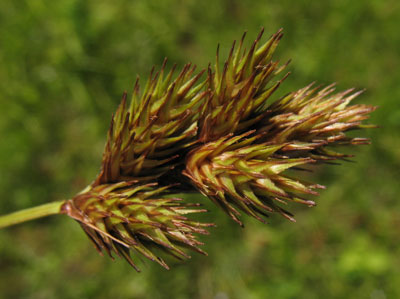DACF Home → Bureaus & Programs → Maine Natural Areas Program → Communities, Plants, and Animals → Rare Plants → Carex waponahkikensis
 Photo by Marilee Lovit
Photo by Marilee Lovit
Carex waponahkikensis M. Lovit & A. Haines
Dawn-land sedge
- State Rank: SU
- Global Rank: G5T2T4
- State Status: Special Concern
Habitat: Open, early successional, and often human-disturbed habitats, including fields, roadsides, and ditches. [Old field/roadside (non-forested, wetland or upland)]
Range: Extreme eastern Maine along the coastal plain.
Aids to Identification: Please see Botanical Notes 14-pdf-286 KB for detailed descriptions about identification for this species. This taxon, formerly known as Carex scoparia var. tessellata, was recently separated from Carex scoparia var. scoparia based on inflorescence length, carpellate scale color, leaf blade width, phenology, perigynia length to width ratio, perigynium beak apex, and distance from scale apex to perigynium beak apex. Well-formed inflorescences of C. waponahkikensis have crowded spikes, relatively broader perigynia, and darker carpellate sclaes, which give the inflorescence a checkered appearance due to the contrast of the scales against the perigynia. For more details, please see the above-noted pdf.
Ecological characteristics: Early successional species of disturbed habitats.
Phenology: Flowers late May to early June, fruits by mid to late June, and these persist until mid to late July. Perigynia begin to be shed by late July and early August. This species flowers and fruits 10-15 days ahead of C. scoparia var. scoparia.
Family: Cyperaceae
Synonyms: Carex scoparia Schkuhr & Willd. var. tesselata Fern. & Wieg.
Known Distribution in Maine: This plant is known only from Washington and Hancock Counties.
Reason(s) for rarity: Limited global distribution.
Conservation considerations: None noted.